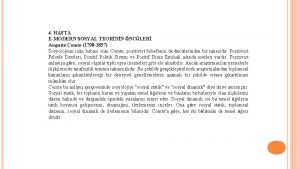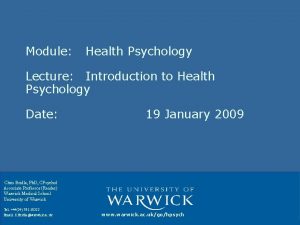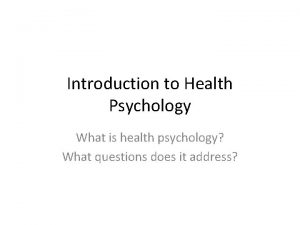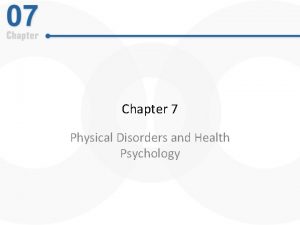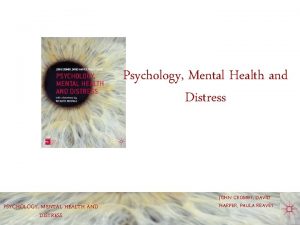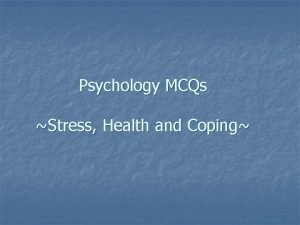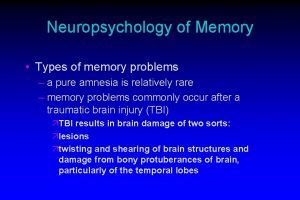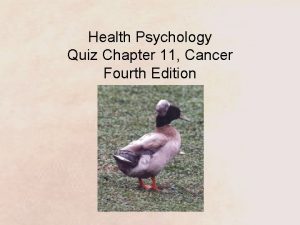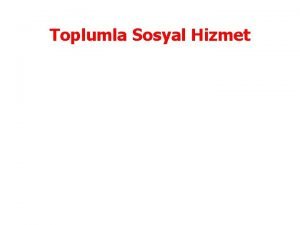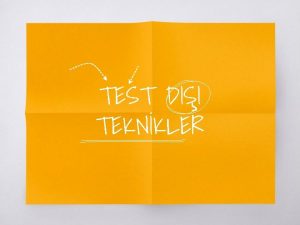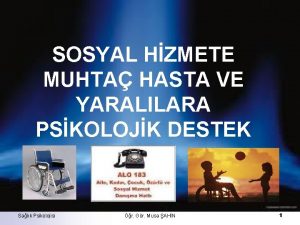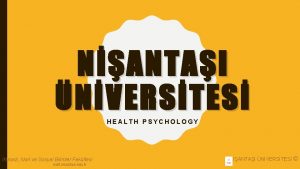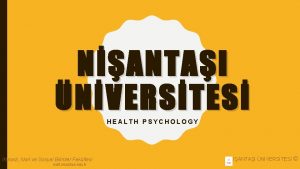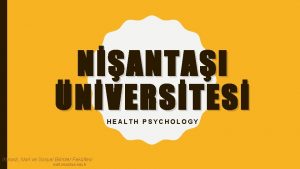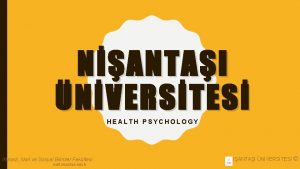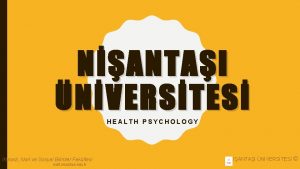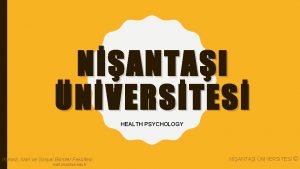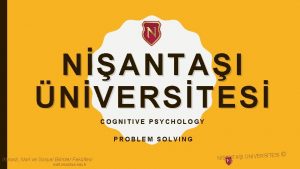NANTAI NVERSTES HEALTH PSYCHOLOGY ktisadi dari ve Sosyal






















- Slides: 22

NİŞANTAŞI ÜNİVERSİTESİ HEALTH PSYCHOLOGY İktisadi, İdari ve Sosyal Bilimler Fakültesi iisbf. nisantasi. edu. tr NİŞANTAŞI ÜNİVERSİTESİ ©

ILLNESS OR DISEASE? Disease: something of the organ, cell or tissue that suggests a physical disorder or underlying pathology. Illness: ‘what the patient feels when he goes to the doctor’ Cassell (1976); experience of not feeling right. How do you know when you are getting ill? Three stages of response: • perceiving symptoms; • interpreting symptoms as illness; • planning and taking action.

CHAPTER 11 STRESS, HEALTH AND ILLNESS: THEORY

LEARNING OUTCOMES By the end of this chapter, you should have an understanding of: • • • stress as a stimulus (stressors) stress as a result of an interaction between an event and an individual the critical role of cognitive appraisal the nature of acute and chronic stress physiological processes invoked by the stress experience how stress manifests itself in various diseases

STRESS AS A STIMULUS A stressful event! Catastrophic events e. g. earthquakes, floods, plane crashes. Major life events e. g. losing one’s job, starting a new job, getting married or divorced, giving birth, being bereaved, going on holiday. • Life events theory (Holmes and Rahe 1967) measures stress of events in terms of Life Change Units (LCU) i. e. average weighted value of the extent of adjustment the event demanded of individuals. Hassles and Uplifts: Minor, everyday events and transactions that cause demands (e. g. deadlines), counter-balanced by enjoyable events and transactions (e. g. good conversation) (Kanner et al. 1981).

STRESSFUL LIFE EVENTS Representative life event items from the social readjustment rating scale and their LCUs Table 11. 1 Source: Holmes and Rahe (1967).

LIFE EVENTS THEORY: LIMITATIONS LCU assigned regardless of desirability of event Age bias in likelihood of life event experience – e. g. childbirth, divorce etc. Events may simply not occur – i. e. low frequency Intertwined life events may cancel out a LCU – e. g. new job and move house Fails to address the moderators of stress – e. g. individual appraisal of events

STRESS AS A TRANSACTION “The mind is its own place, and in itself can make a heaven of hell, a hell of heaven” Paradise Lost, John Milton (1608– 74) Stress is a subjective experience! Lazarus 1993: Stress is a result of an interaction between an individual’s characteristics and appraisals, the external or internal event (stressor) environment, and the internal or external resources that a person has available to them. Motivational and cognitive variables are considered central.

TRANSACTIONAL MODEL OF STRESS Figure 11. 1 Lazarus’s early transactional model of stress Source: adapted from Lovallo (1997: 77).

APPRAISAL PROCESSES Primary appraisal processes Person considers quality and nature of a stimulus event: – those that pose harm; – those that threaten; – those that set a challenge. Secondary appraisal processes Assessment of one’s resources and abilities to cope with the stressor (coping potential): – internal resources (e. g. determination, knowledge, strength); – external (e. g. social support, money).

APPRAISALS ILLUSTRATED Consider forthcoming examinations as a potential stressor: There is no way I can possibly deal with this, I simply know I will fail (threat + no resources = stress) This will be really hard, I just am not as clever as the other students (threat + limited internal resources = stress) Maybe I can manage this, if I revise really hard (challenge + possible internal resources = less stress) I could perhaps do it if I get some help from my friends (challenge + external resources = less stress) This isn’t a problem, I know the material really well (benign, no stress) I managed to pass the last time, I’ll be okay this time (benign, no stress)

DEVELOPMENT OF PRIMARY APPRAISALS (LAZARUS 1991; SMITH AND LAZARUS 1993) Motivational relevance: i. e. extent event is relevant to goals Motivational congruence: i. e. extent situation is congruent with goals Ego involvement: i. e. appraisals of threat to self-esteem/moral code elicit anger, guilt, anxiety Cognitive appraisals of harm, threat and challenge were attached to emotion types e. g. Table 11. 2 Appraisals, core-related themes and emotions Source: adapted from Hulbert-Williams et al. (2013).

DEVELOPMENT OF SECONDARY APPRAISALS (SMITH AND LAZARUS 1993) 1. Internal/external accountability (‘blame/credit’): attributing responsibility for the event. Distinguishes between anger (otherblame) and guilt (self-blame) emotions. Credit may associate with pride. 2. Problem-focused coping potential*: the extent to which the situation is perceived as changeable by instrumental (practical, problem-focused) coping options. If not, fear and anxiety may result. 3. Emotion-focused coping potential*: perceiving an ability to cope emotionally with the situation. If not, fear, sadness and anxiety may result. 4. Future expectancy concerning situational change: perceived possibilities of the situation being changeable. Perceived unchangeability may cause sadness. * Lazarus merged 2 and 3, referring simply to ‘coping potential’.

WHAT FACTORS INFLUENCE APPRAISAL? There are many aspects of the stimuli event itself which can influence the appraisals that a person makes. • Events that are imminent (e. g. medical results due the next day; driving test that day). • Events at an unexpected time in life (e. g. being widowed in one’s 40’s). • Events that are unpredictable in nature (e. g. being made redundant). • Events that are ambiguous in terms of ‒ personal role (e. g. starting a new job). ‒ potential risk or harm involved (e. g. undergoing surgery). • Events that are undesirable (e. g. moving house due to job loss). • Events over which the individual perceives no control (behavioural or cognitive, e. g. noisy neighbours). • Events that elicit high amounts of life change (e. g. childbirth).

TYPES OF STRESS Stress and resource loss Stress will result when there is actual or threatened loss of resources, or a lack of gain after investing resources (Hobfoll 1989). Acute stress Chronic stress Natural catastrophes symptoms: Job features associated with occupational stress: • • Panic Phobias Survivor guilt Isolation, withdrawal etc. Examination stress impairs: • • Memory Attention • • • Demand Controllability and perceived selfefficacy Predictability Ambiguity Lack of support

ASSESSING OCCUPATIONAL STRESS Table 11. 3 Examples of items to assess work-related stress Source: adapted from Rice (1992: 188– 92).

STRESS AS A PHYSIOLOGICAL RESPONSE ‘Fight or Flight syndrome’ (Cannon 1932): Role of Sympathetic Nervous System. ‘General Adaptation Syndrome’ (Selye 1974): A three-stage stress response: Alarm reaction: initial awareness of a stressor can cause a downturn in bodily defenses and blood pressure; heart rate may initially decrease before rising to higher than normal levels. Cannot be maintained for long periods. Stage of resistance: body tries to adapt to a stressor that has not subsided in spite of resistance efforts made during the alarm stage. Arousal reduces but is still higher than normal. Mobilisation of bodily defenses cannot last indefinitely without becoming vulnerable to illness. Stage of exhaustion: occurs if the resistance lasts too long, resulting in a depletion of bodily resources and energy. Ability to resist stress declines and a likelihood of ‘diseases of adaptation’ increases, such as cardiovascular disease, arthritis, asthma.

PHYSIOLOGY OF STRESS Selye’s ‘non-specific’ stress response unsupported by evidence of different responses to different stressor types e. g. mental stress vs. physical stress. Role of sympathetic and parasympathetic nervous systems. • Role of adrenalin, noradrenalin (SNS) and acetylcholine (PNS). Activation of the sympathetic-adrenomedullary (SAM) system. Action of the hypothalamus and the hypothalamic-pituitary adrenocortical (HPA) system.

THE HPA SYSTEM Schematic diagram of the hypothalamus-pituitary-adrenal (HPA) axis. Stimulatory and inhibitory paths are indicated by the arrows and + or – signs respectively. CRF represents corticotropin releasing factor and ACTH represents adrenocorticotropic hormone. Figure 11. 3 Source: Adapted from Lenbury and Pornsawad (2005).

STRESS AND IMMUNE FUNCTION DYSREGULATION Alterations or declines in immune function are frequently associated with the experience of stressful life events. The immune system is the body’s defence against disease. Immune function declines with age, stress can exaggerate the effects of aging on immune Table 11. 4 Specific immunity and cell types competence.

STRESS AND ILLNESS LINK The direct route Stress can produce physiological changes that may lead to the development of illness, particularly in instances where the stress is chronic. The indirect routes (a) People, by virtue of their behavioural responses to stress such as smoking, eating habits and drinking, predispose themselves to disease. (b) People, by virtue of certain personality traits, predispose themselves to disease by the manner in which they respond to stress. (c) People experiencing stress are more likely to use health services than people who are not under stress. Stress can produce symptoms such as anxiety, fatigue, insomnia and shakiness, which people seek treatment for but which aren’t in themselves illnesses.

STRESS AND ILLNESS Stress and the common cold: the common cold virus (submitted via nasal sprays) was more likely to develop in those who report more chronic life events, perceived stress, negative affect and poor coping (Cohen 2005). Stress and cancer: stress may affect tumour cell mutation by slowing down the cell repair process (Rosch 1996). Mixed evidence of stressful events and cancer recurrence (Graham et al. 2002; Palesh et al. 2007). Stress and bowel disease: symptoms of irritable bowel syndrome and inflammatory bowel disease increase during stressful episodes such as pain or diarrhoea (Nailboff et al. 1998; Duffy et al. 1991). Stress and HIV: stress may increase speed of symptom onset in HIV +ve individuals via effect on NK cells. Depression may affect CD 4+ cell count and progression to AIDS (Burack et al. 1993; Page-Shafer et al. 1996).
 Nantai cash
Nantai cash Nantai 37
Nantai 37 Ncler
Ncler Health psychology definition ap psychology
Health psychology definition ap psychology Positive psychology ap psychology definition
Positive psychology ap psychology definition Polarization psychology
Polarization psychology Fundamental attribution error ap psychology
Fundamental attribution error ap psychology Introspection method in psychology
Introspection method in psychology Social psychology is the scientific study of:
Social psychology is the scientific study of: What is health psychology
What is health psychology Introduction to health psychology
Introduction to health psychology Physical disorders and health psychology
Physical disorders and health psychology Psychology, mental health and distress
Psychology, mental health and distress Concept of stress and coping mcqs
Concept of stress and coping mcqs Health psychology associates
Health psychology associates Enrich health and psychology
Enrich health and psychology Health psychology quiz
Health psychology quiz Toplumla sosyal hizmet nedir
Toplumla sosyal hizmet nedir Rol dağıtım tekniği nedir
Rol dağıtım tekniği nedir Sosyal algı ne demek
Sosyal algı ne demek Amprisizm
Amprisizm Sosyal psikolojide araştırma yöntemleri
Sosyal psikolojide araştırma yöntemleri Sosyal hizmete muhtaç hastaya psikolojik destek
Sosyal hizmete muhtaç hastaya psikolojik destek


